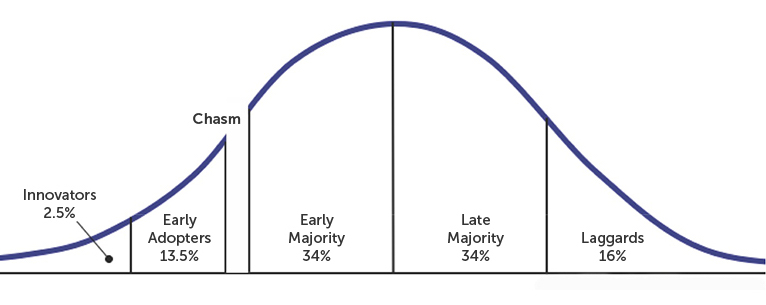Crossing the Chasm
Intro
As always, I don’t agree with or use everything I read, but I will still try and summarize it here. If you are new here, read why I put my semi-personal book notes online.
This book is so concise, I loved it. Even though it is relatively concise it’s a pretty dense and informative read. As an engineer, having a product book that looks at the marketing and selling aspects of a product was extremely valuable. In some ways, this books feels like the complement to one of my favorite books, The Pragmatic Programmer. I recommend all engineer founders to read this. Also, if you are an engineering lead, this is a good book for you to be able to understand why product and business do some of the things they do. That can give insight into how to make your engineering team serve the end customers better.
Visionaries are that rare breed of people who have the insight to match up an emerging technology to a strategic opportunity, the temperament to translate that insight into a high-visibility, high-risk project, and the charisma to get the rest of their organization to buy into that project.
Summary
In short, this is a book that talks about the gaps between technology businesses and markets. It’s a guide on how to bring technological-based products to market.
Transitions
The transition from early adopters to mainstream is very important. Most assume that transition will happen quietly. The plan needs to address the difference between a few motivated early users and broader late users.
Most users are late adopters. New technology is not only disruptive to a market but also inconveniently disruptive to a user’s workflow. When developing a new product, I like to pay a lot of attention to the current workflow of a user. All things equal, I minimize disruptions to the user’s workflow especially at the beginning of their process.
Markets
Aka consumer audiences

Other products that also started with specific niche markets and then proceeded to conquer bigger markets include Oracle, IBM, and Google. The hedgehog section Good to Great related to this idea of starting with a niche product and expanding out. In Crossing the Chasm he applies it from the perspective of the audience.
Innovative
The smallest segment that encourages others to investigate the product. The active and aggressively pursue new technology because it’s a central part of their lives. Appealing to this segment is the first step. Many early adopters look to these innovators.
Early Adopters
Instead of the technology being a central part of their lives, this group is drawn to the benefits of the technology. They rely on intuition and vision. These are the “visionaries” looking to find more efficient ways to perform their JTBD.
Early Majority
They don’t care about fads, so they will wait. This group wants to see well-established references before investing any substantial time and effort into a product. This segment is large and appealing to this segment requires a fundamental shift in marketing tactics. Practicality above all else.
Late Majority
This group wants to see that all bugs have been fixed and want to be able to ask someone for help when they need it. FAQs are likely not good enough for this group. This group is not comfortable in their skills when dealing with a technological product.
Laggards
Generally not interested in technology. This is the group that is probably still would prefer to use a taxi instead of uber for all use cases.
Crossing
The chasm needs to be crossed at some point. One strategy is to incentivize your early adopters to target the early majority. I’m not sure what kind of specific advice this book really gives to deal with this, but at least be aware that the strategy to cross this abyss will require a different marketing strategy. The author suggests the market strategy is more important here. From a product perspective, this means the new customer segment you are building and validating for is the early majority. See The Lean Startup for ways to pivot the product to appeal to this new group of users.
Keep in mind it’s not just the technology that may have to expand but all the experiences around the product itself. One very specific example of this given by the author is how the late majority would likely want to ask someone for help when they need it. This is not a direct application feature but still your “product” as a whole.
Launching
When launching the product, delays are your enemy. You won’t have statistically significant data so you’ll need to use something that’s a hybrid of intuition and information. The author calls that informed-intuition.
Do not only focus on the implemented technology or the product but on how the industry will change as a result of the innovation.
Price
These changes are based on each segment. Visionaries tend not to be very sensitive to price; if they need the feature they will pay for it. Consumers who buy later in the product cycle will be price-sensitive but will still pay 30% more for a product from a marketing leader. If you aren’t the market leader, compete on price by selling for 30% less.
Crossed
It’s not over when you have crossed the chasm into the next market segment. Internal changes may need to happen to change the culture. Product changes will need to occur as driven by the new segment.
Outro
This is a must-read for every startup entrepreneur. But it’s not just for cofounders, it’s for anyone who has a technology product looking to expand into broader customer segments. Or as the author might put it, the “next customer segment”. I’ve already set a reminder to re-read this book in 1 year, I’m hoping there is even a new edition by then 🤞.









